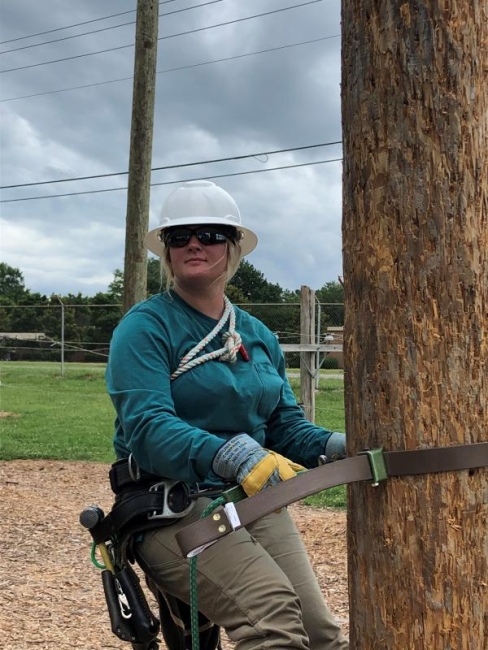You have /5 articles left.
Sign up for a free account or log in.

Massie Calvin
Calhoun Community College
Massie Calvin spent seven weeks climbing up and down 40- and 80-foot poles for about seven hours a day and learning how to set and repair electrical lines as part of a training program at Calhoun Community College. She climbed up and down a 40-foot pole about 25 times in a single day, as part of what’s known as “hell week.”
The program was hard, but Calvin stuck with it and became the first woman to graduate from the Alabama community college’s pre-apprentice line worker program last month under a new initiative to recruit women to the field. Only one other woman has ever graduated from the program, in 2013. Calvin made a spontaneous decision to enroll in the program after seeing an ad on Calhoun’s website promoting the new effort. She was partly inspired by her grandfather, a retired line worker.
“I kind of wanted to follow in his footsteps, and I also wanted to make a name for myself as well,” she said. “I wanted something for my family to look back on and be proud of me.”
Calhoun Community College reserved 10 seats in the program for women and fully subsidized the cost of tuition, equipment, transportation and childcare as part of a push to attract more women to the program this summer. Care for Calvin's two children, ages 2 and 5, was covered as a result. Funding for the effort was provided by a grant of about $49,000 from the Women’s Fund of Greater Birmingham, a local philanthropic organization focused on increasing economic opportunity for women. The grant also paid for a career coach for the participants.
“They really didn’t need to put anything into the course but time and sweat,” said Houston Blackwood, director of workforce solutions at Calhoun. “Those are the only two things they had to invest.”
There’s been a “pretty long-standing” push among community colleges to bring more women into utilities and skilled trade fields, said Deborah Kobes, senior director at Jobs for the Future and deputy director for its Center for Apprenticeship and Work-Based Learning. She said “attracting a wider range of potential students” is in the best interest of the colleges at a time when many are experiencing enrollment declines. Graduating more women is also a way to meet local employer demand for more diverse workers.
“A lot of employers say they want to hire more diverse talent but they just can’t find that talent,” she said. “If you’re a community college or educational institution or training provider that is able to recruit women into your program, then you’ll be turning around or graduating somebody or getting somebody into an apprenticeship program who’s really desirable among employers.”
More women appear to be entering line work, construction, manufacturing and other skilled trade fields in recent years, but men continue to dominate these trades and the training programs that are a pipeline to jobs.
Data from the U.S. Department of Labor show women made up just 11.6 percent of people who completed apprenticeship programs in the 2020 fiscal year -- 4,204 women compared to 32,191 men. Three years earlier, only 7.3 percent of the people who completed apprenticeships were women, according to a 2018 study by the Center for American Progress, a liberal think tank.
Kobes noted that it’s hard to tell from apprenticeship data how much progress women have made breaking into utilities and skilled trades, because apprenticeships are now increasingly common in fields that tend to include more women, such as health care.
The numbers could be “a lot better,” said Susan Blaser, who coordinates the line worker program at Metropolitan Community College in Missouri. The program graduated just five women in the past 30 years, including Blaser, who became the first female line worker in in the state in 1992. She said she visits high schools and tries to recruit a diverse pool of applicants, but she finds parents and schools don't encourage young women to enter these kinds of fields.
“The 2021 class I have coming up, I have no females at all,” she said. “None even applied.”
Blackwood found recruiting women to be easy, but retaining them was hard. Ten women registered for the Calhoun pre-apprentice line worker program a month before classes started, but they dropped out one by one. Some didn’t respond to follow-up messages from the college leading up to the program. Another had to tend to a sick family member. Five women remained by the first day of classes, and only Calvin made it through the rigors of the pole-climbing portion of the program. The other women earned commercial driver’s licenses as a part of their training and can still work with career services to get jobs that use their new skills, even if they don’t become line workers, Blackwood said.
He’s not sure Calhoun will try the “lady line worker” initiative again because of the attrition rate, but the college applied for a new round of funding to support a cohort of women wanting to earn commercial driver’s licenses.
Calvin, the newly minted line worker graduate in Alabama, believes women aren’t typically encouraged to pursue jobs as physically demanding as line work. She credits her father for involving her in yard work and construction projects growing up and described her family as “very supportive” of her decision to enroll in the program at Calhoun.
“A lot of women, they don’t have anyone to teach them that type of stuff,” she said. “It kind of scares a lot of girls. They think that they can’t do it because they don’t know anything about it.”
Blaser said the work culture can also be intimidating -- for anyone, let alone the “token female.”
In her experience, both men and women are harshly “criticized” and “cussed at” as apprentices, but “women have to work twice as hard to be thought of as half as good,” she said. “You’re in a male-dominated field and you need to adapt to your surroundings and your situation so that you can survive.”
She said sometimes she’d get home and just lie down on the floor and cry, but it was all worth it when she completed her apprenticeship and became a “journeyman.”
“All the mouths were closed, and all of a sudden you’re treated with respect,” she said. “It’s pretty awesome.”
Calvin said she wasn't treated any differently by her male classmates or instructors.
“They never gave me special attention because I was a girl,” she said. “If there was something I needed to do, that I was told to do, they didn’t come up to me and be like, ‘Hey, are you sure you don’t want me to get that?’ They knew I was going to do it regardless.”
She believes colleges should do what Calhoun did to attract more women to skilled trade programs -- market seats designated for them so applicants know they won’t be the only woman in the program. Even though she was ultimately the only female graduate, she said even the possibility of other women participating attracted her to the program.
“I feel like a lot of girls or women kind of feel on the back burner, like they can’t do it or they’re going to be judged by other guys if they were the only girl,” she said. “If there were more girls there for programs like these, they could have the support of another girl.”
Local partnerships with trade associations, adult education programs, employers and companies, and local youth-related nonprofits are also key for creating more diverse pipelines into training and apprenticeship programs, said Amy Firestone, vice president of Apprenticeship Carolina, a division of the South Carolina Technical College System that promotes apprenticeships in the state. Nearly 20 percent of registered apprentices in South Carolina are women, higher than the national average, according to 2020 U.S. Department of Labor data. Firestone credits proactive outreach and a strong network beyond the college system for the higher numbers.
Katie Spiker, managing director of government affairs at the National Skills Coalition, said policy changes could also help draw more women into these fields. She co-authored a 2018 report on diversifying apprenticeship programs.
The federal government makes some targeted investments directed at women in skilled trade programs, she noted. For example, she pointed to the Women in Apprenticeship and Nontraditional Occupations Act, established in 1992, which enables the U.S. Department of Labor to give funding to nonprofit organizations in certain industries to recruit and retain more women in these fields.
However, Spiker said, there’s been “far too little investment” in apprenticeships and skilled trade training programs at the federal level over all, which contributes to “drastic underinvestment” in strategies to increase women’s access.
She believes subsidized childcare for women in these programs would make a “meaningful difference” for recruitment. She cited Women in Construction, a pre-apprenticeship program in Missouri, as an example. The program is run by Moore Community House, a nonprofit organization focused on economic security for women. The program tripled women’s annual enrollment from 60 to 180 by putting state grant money toward a year of paid childcare. Spiker noted that this level of support is “pretty rare,” however, because it’s expensive to provide.
“Without some sort of comprehensive federal focus and investment in strategies that help women, people of color, people who don’t have education past high school be able to access the kind of job training and the kinds of supports that they need to access good jobs, there’s not going to be a meaningful shift that’s going to raise the amount of women in these kind of industries,” she said.
Blackwood, of Calhoun Community College, said he’s hopeful colleges will recruit more women to utilities and skilled trade programs, even if the women line worker initiative wasn’t a “grand slam.” He believes Calvin’s graduation story will inspire other women.
“We’ve had several females since then inquire about the course, and we encouraged them to apply,” he said. “I anticipate we’ll have more females in the class than we’ve had in the past. She tells her story very well. She’ll be an influence to other women to recruit them into the field. I’m 100 percent confident of that.”









